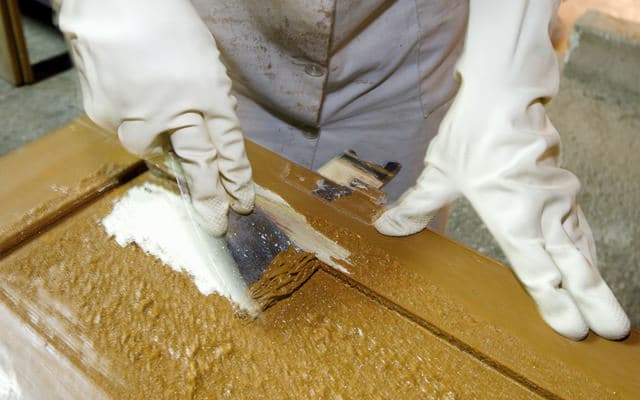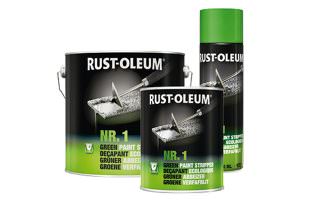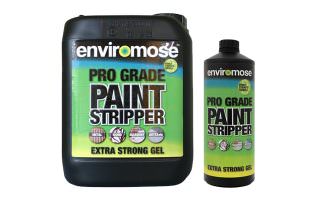Paint strippers for home, commercial and industrial use.
We’ve recently received feedback from clients advising us that the paint stripper they are using is not performing how they are used to it to. This is no fault of their own, but is due to recent legislation from the EU banning the use of certain hazardous chemicals in the formulation of paint strippers and removal products. This recent legislation has had a knock-on effect on the performance of paint strippers. So now the question is being asked which paint stripper is best?
The answer to this question would depend on the type of paint or coating you are intending to remove and the substrate type you are stripping the coating away from. Below we will detail a few of our go to paint strippers and their uses. As well as some helpful tips and hints on how to get the best out of the paint strippers, even detailing how to remove tough textured coatings such as the dreaded Artex.
How to use a paint stripper?

Firstly, it’s advisable to ascertain what type of coating or paint you are trying to remove. If you are unsure of the coating or paint type it’s best to try a small test area first to check the results are desirable.
Below we have outlined a few tips and hints on how to get the best performance from your paint stripper:
Safety first
Always follow the manufacturers safety procedures and wear the appropriate PPE (personal protective equipment).
How old was the coating? – The newer the coating the more difficult it is to remove and the more work required to remove it. So bare this in mind when planning the works.
Where are you using the paint stripper? – Is it internal or external and how warm is it?
The general rule is when using a paint stripper in an external or warm environment, the quicker the paint stripper will evaporate. This can be overcome by applying a good thick coat. Another tip is to cover the stripper with cling film or a polythene sheet. Tape around the edge to stop the air from drying out the paint remover. Newer paint strippers do not react as fast as the old Nitromors ( DCM aka Dichloromethane, better known as Methylene Chloride, which was banned for DIY use in 2016), so we suggest you leave it to work over night, this will stop the evaporation and allow the stripper the time it needs to really penetrate and breakdown the paint or coating.
Paint remover vs sanding?
The answer to this is a combination of both. Sanding the surface breaks the film of the paint and allows the stripper to enter. This is especially true when stripping 2 pack paints such as epoxies and polyurethanes, which have a particularly hard surface film.
Tough coatings
Another factor to bear in mind is that thicker or 2 pack coatings or paints may require several applications of paint stripper to effectively remove the coating.
What type of paint stripper do I buy?
Promain has a comprehensive range of paint strippers available from leading manufacturers. Below, we will run through the uses and methods of application of just a few of our go to paint removal products. Hopefully this will help you to purchase the correct paint remover for your project.
DSP 800
Owatrol DSP 800 is an extremely powerful and versatile solvent based paint stripper that has been formulated without the EU banned chemicals.
DSP 800 can be used to remove most coatings, including both single and 2 pack alkyds, acrylics, polyurethanes, epoxies, cellulose, RSE (semi-thick coating), RPE (thick plastic coating) and even carpet glue. It can also be applied to virtually any substrate type apart from plastic. This is a fast working paint stripper and surfaces can be ready for recoating in as little as 6 hours. DSP 800 has a theoretical coverage of 1.25 – 4 m2 per Litre. Actual coverage will depend on the type of finish, numbers of coats being stripped and the thickness of DSP 800 applied.
Before using DSP 800, ensure you fully read the manufacturers technical data sheet, making sure you follow all instructions and safety procedures.
Before application, abrade or sand the surface to break the coating film. This will aid the DSP800 in penetrating and breaking down the coating. Following the sanding, it is then advisable to carry out a test by applying a uniform layer of DSP 800 and allow to work. Periodically test with a scraper to see if finish is softening.
When the coating is soft, has blisters or cracks and you can easily remove it, then the optimal working time has gone by. If after 45 minutes there is no result, apply again and continue test.
Once we have confirmed the DSP 800 test area is successful, apply a uniform layer of DSP 800 and allow to work in accordance with the test carried out above. Remove stripper and coating with a scraper or scrubbing brush. On delicate wood use a soft brass brush. On interior wood use a scraper or soft brass brush.
Once you have completed the stripping away of the coating or paint, ensure you remove any paraffin residue by rinsing the surface with warm water, White Spirit, Acetone or by mechanically sanding with 80, 100 or 120 grit sand paper.
Rustoleum Hard Hat Greener Paint Stripper

Rustoleum Hard Hat Greener Paint Stripper is formulated without methylene chloride and designed to offer quick removal of tough paint coatings in a matter of minutes.
You can use Greener paint stripper for stripping paints both internally and externally. It is also environmentally friendly. You can use this to remove a variety of paints and products. This includes emulsions, alkyds, varnishes and most 2 component tough coatings. You can use this on both horizontal and vertical surfaces at temperatures as low as 0°C.
This is also suitable for paint removal from metal, mineral and wooden substrates. You can also use it on plastic surfaces too. We advise you perform a test area to ensure that no damage is occurs to the substrate.
Before using the product ensure you follow all the recommended safety procedures and wear the appropriate PPE. Always fully read the manufacturers technical data sheet and follow the manufacturer’s instructions.
Preparation
Prepare the substrate you intend to strip by scraping the surface to remove as much loose material as possible. Next, carefully open the container and using a disposal brush (do not use synthetic brushes). Apply a thick even layer to the surface. Allow the product to stand for 10 -15 minutes. Use a filling knife or paint scraper to remove the layers of paint from the surface. 2 pack paints and multiple layers may require a repeat application. Once the coating has been stripped away, thoroughly clean the surface with either Rustoleum ND14 Cleaner and Degreaser, fresh water or a high pressure steam cleaner and allow to fully dry before applying any paints or coatings.
Enviromose Pro

Enviromose Pro Water Based Artex Remover incorporates a cutting-edge formula for quick and easy removal of Artex and other textured coatings. You can use this extensively in the asbestos removal industry, along with contract stripping companies and local authorities. We have been supplying Enviromose Pro in bulk to asbestos removal companies for several years. They continually feedback to us that they feel it’s the best product on the market as it is both low hazard and low odour.
As with all paint strippers, always consult the technical datasheet before use. Ensure you follow all safety procedures and wear the required PPE. Here you can find instructions on how to remove Artex using Enviromose Pro.
Application
Before applying across the whole area, it is best practice to establish correct removal timings and suitability. Always test an inconspicuous area before use. Create 6 small test samples of no more than 50mm round with the liquid generously applied (approx. 1sq mtr per ltr). Apply the 6 samples at the same time – spaced sufficiently apart to allow individual washing and removal.
Remove 1 sample at a time, at 60 minute intervals. This will give you the correct timing for the product. Whichever sample is perfectly clean after washing, this is the timing you will need for the whole area.
Following the above test, using a suitable brush apply a generous even coat at a rate of 1m2 per litre. Leave for the appropriate time established by the test samples (as above). Do not shortcut the process. The coating needs to be thick and left for a sufficient time to penetrate the coating.
Let the stripper work into the surface. Remove all the coating by using a scraper and a stainless steel scourer dipped in soapy water. Allow the substrate to fully dry before applying any paint or coatings.
Help and Assistance
If you have a paint or coating you are struggling to remove, why not take advantage of our technical expertise by calling Promain on: 01462 421 333. We will be happy to assist with any project you are undertaking and guide you moving forward.

